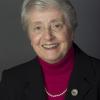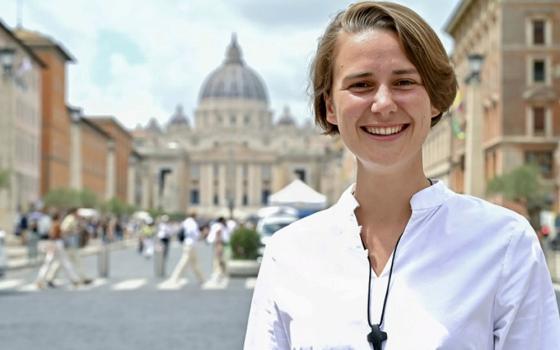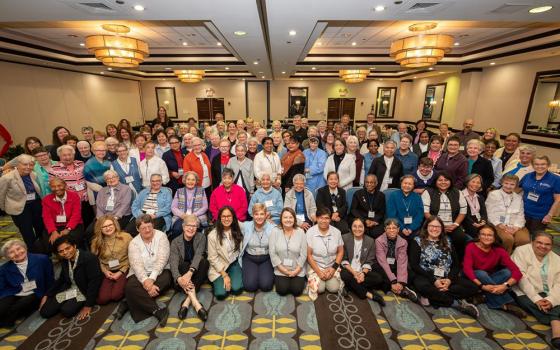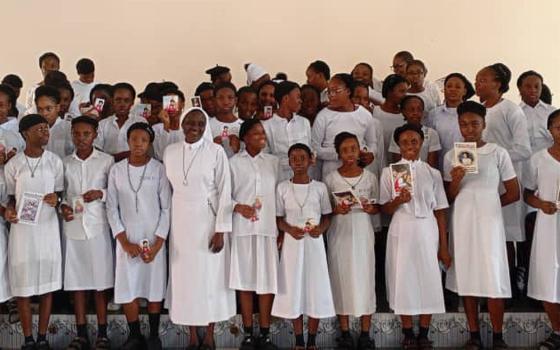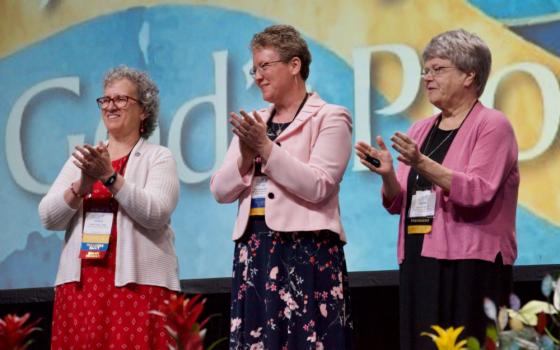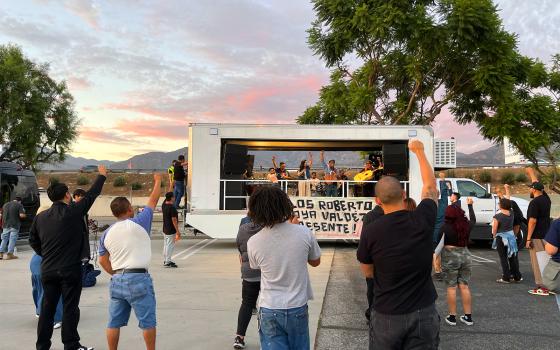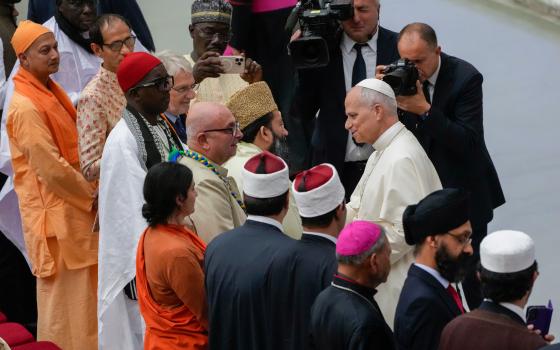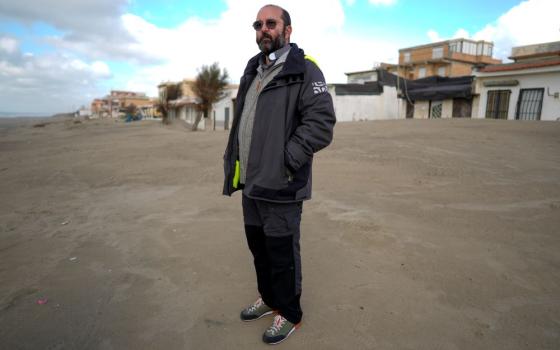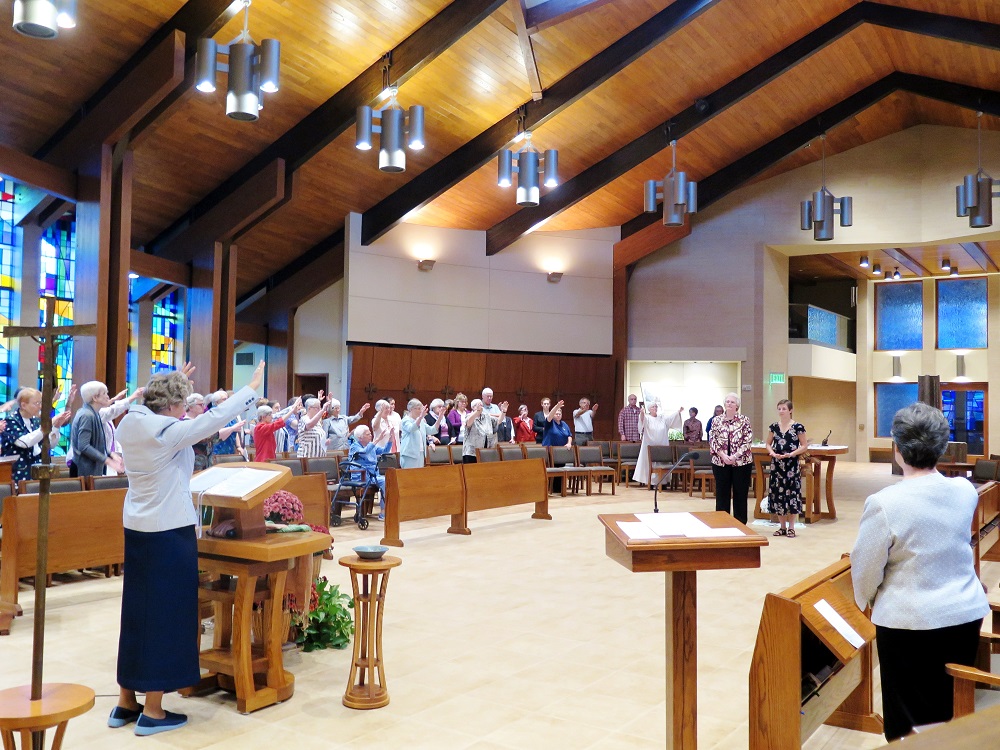
The Benedictine Sisters of Erie, Pennsylvania, bless Sr. Valerie Luckey, in black dress, at her first profession Oct. 21, 2017. (Courtesy of the Benedictine Sisters of Erie)
Editor's note: Noted theologian Sr. Sandra M. Schneiders recently gave a presentation for FutureChurch as part of its "Women Erased" series about religious life and how it is evolving. We are reprinting her talk, which has been edited slightly for clarity, with her permission and that of FutureChurch. Schneiders is a member of the Sisters, Servants of the Immaculate Heart of Mary of Monroe, Michigan; professor emerita of New Testament studies and Christian spirituality at Jesuit School of Theology at Santa Clara University; and author of Prophets in Their Own Country: Women Religious Bearing Witness to the Gospel in a Troubled Church and other publications.
It is a pleasure and a privilege to join FutureChurch and my illustrious predecessors in this "Women Erased" series.
I have to confess that I have been, from the beginning of my discussions with Deborah Rose-Milavec about this lecture, both fascinated and a bit uncomfortable with the topic. Obviously, as all the women who have presented in this program have abundantly demonstrated, women in the Christian, but especially in the Catholic, tradition have been marginalized, dismissed, used, denigrated, and even abused in and by the male custodians of the Christian tradition since very shortly after the New Testament period, if not even within it.
But this notion of erasure or obliteration, given that women believers are and probably always have been the majority of participants in the Christian tradition, puts a particular spin on the subject. To ignore, denigrate, abuse, exploit, oppress, etc., implies attention, even if negative, to the object of the mistreatment. To erase, on the other hand, is to render nonexistent, invisible and unavailable, even for mistreatment. To erase really means to annihilate — from existence, consciousness, discourse, as well as success or contribution. To erase is to remove from the sphere of attention altogether. And beyond simply ignoring, i.e., overlooking, erasure suggests a deliberate and successful attempt to annihilate something that already exists.
The lectures that have preceded this one have documented such erasure, such annihilation of the influence and contribution if not the actual person or presence of women in sphere after sphere of Christian experience: church leadership and governance, art, liturgy, history, biblical interpretation, sacramental ministry and so on. The forms of erasure have included not simply ignoring women and their activity and influence in the church's linguistic tradition, i.e., in the lectionary and homiletic tradition, but deliberate exclusion by omission of women-inclusive liturgical texts or, conversely, emphasis on texts that denigrate women. The exclusion of women from office, liturgical ministry, pastoral leadership and authority and, so on, primarily by their exclusion from ordained ministry, needs no documentation.
However, my area of specialization in regard to women in the church has been, largely, in the areas of biblical studies, especially the New Testament, and, for our purposes in this context, on the history, theology, and spirituality of religious life in which, historically and numerically, women's involvement has been and is far more extensive and, in my humble opinion, more interesting, than that of men whose experience of religious life has been largely (although not totally) subsumed into the clerical ethos and agenda since very early in the church's history.
Since previous speakers in this series have concentrated on women in Scripture, I decided to concentrate today on women in religious life; that is, women religious: their identity, history, struggles, challenges, current traumas and triumphs, and discernible future, which promises to be a rocky road for the immediate future.
And this is where, suddenly, the issue of "erasure" became highly ambiguous for me. Are we, women religious, in a process of being erased — that is, disappeared? If the answer is yes, by what or by whom are we being erased, and with what foreseeable consequences for women, the church, and the world? And if not, is there any probative evidence on which to base such a judgment, or are we simply whistling cheerfully past the cemetery? Or, more literally, are we (i.e., women currently in religious life), just hoping that we, personally, will be safely in the next life before the charismatic, or at least institutional, ship called religious life goes down?
Even the recent double attack by the Vatican on U.S. women's religious life from 2009 to 2012, euphemistically called an "evaluation" of their leadership and a "visitation" of their communities, were not really aimed at erasing the life. If their unacknowledged objectives had been accomplished, it might well have constituted an erasure of the life or at least of its most interesting and constitutive feature, namely, its prophetic identity and mission in the church and the world. But, whether or not obliteration or erasure was the agenda, it did not happen, and religious life in this country emerged relatively unscathed; indeed, in some senses, it is strengthened and emboldened in the eyes of Catholics and non-Catholics alike and more internally united and self-confident.
But even if religious life has survived the hierarchical attempt to domesticate it into irrelevance, we might still consider that the term "erasure" applies to contemporary religious life, especially that of women, because of the demographics and economic realities currently challenging it.
Without rehearsing well-documented, widely known, and distressing statistics in detail, it will suffice for our purposes to recall a few indisputable and symptomatic facts: e.g., in 1965, there were 180,000 women religious in the United States, the majority of whom were below the age of 50, and today, there are somewhere between 30,000 and 50,000, whose average age is 74.
Rather than annual double-digit entrance classes of teenage high school graduates ready to be trained in and deployed by their respective congregations into its well-institutionalized and highly respected ministries and the majority of whom would persevere, today's entrants are usually lone individuals, at least college graduates (often saddled with debt), and usually closer in age to 40 or even 50 than 20. Only 1% of women religious today is below age 40. Even someone as mathematically challenged as I can see that these indisputable facts seem ominous.
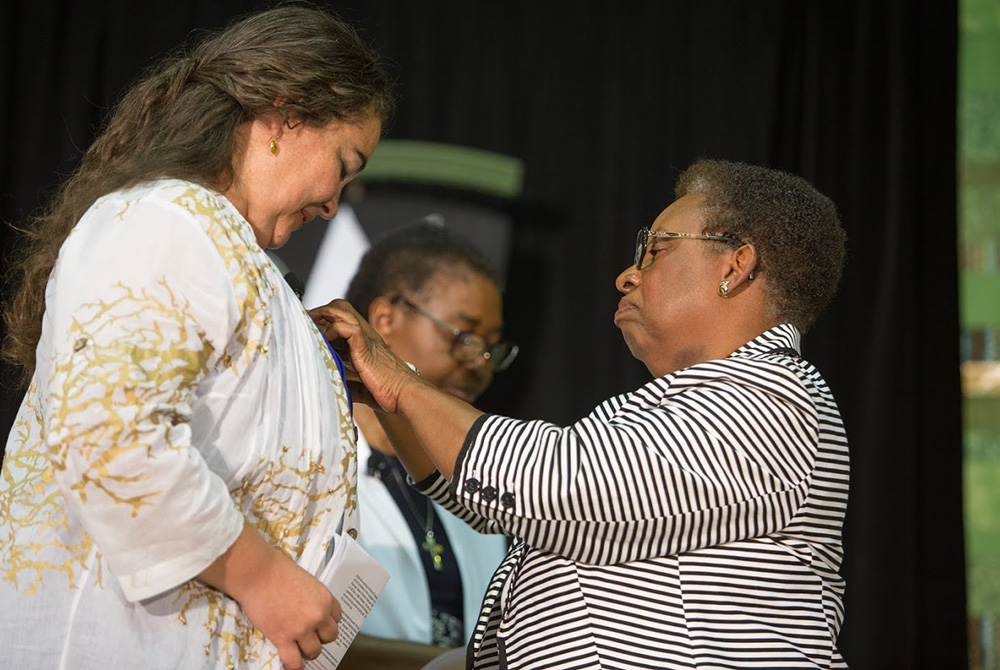
Sr. Ana Gonzalez, 39, with Sr. Pat Dual, director of formation for the Dominican Sisters of Peace on July 13, 2018. Sr. Margaret Uche, who also made her vows that day, is in the background. (Courtesy of the Dominicans of Peace)
What is puzzling to many current women religious, most of whom are in their late 60s to 90s, is that these very few newer members who are in their 30s to 50s and who will soon inherit a vastly changed community and ministerial reality without the cushion of 20 or 30 years of experience in the life or a cadre of seniors to run the show and mentor them until they are ready to assume leadership do not seem unduly stressed or distressed by this existential situation. In fact, most of the ones I know are joyously (and, in their eyes, realistically) anticipating their post-perpetual-profession lives. One can't avoid wondering if they living in a dream world, or if they are the only religious living in the real world. But perhaps you can understand why, when asked to speak about the erasure of women religious or of women's religious life, I found it difficult to situate myself in relation to the facts on the ground, much less the theological implications of those facts.
But there is another, perhaps equally puzzling feature to the current reality of women's religious life, which is, as I have just said, widely seen by its admirers as well as its critics to be on its way out; that is, on the brink of demise. It is the emergence, in the same recent time period as the precipitous decline in entrants into religious life and not due as far as I know to anyone's planning or orchestration, of a long list of remarkable examples of what women's religious life is and fosters and produces.
I am not referencing what an earlier historical period or developmental stage of the life produced, e.g., the monasticism of the Middle Ages or the apostolic works of congregations in the early modern period, which are still with us to some extent in Catholic hospitals and schools and social service enterprises, still owned and/or operated if no longer staffed by religious congregations. I am talking about what today's version of religious life is fostering and supporting.
In the last few years, we have all witnessed or participated in the emergence into national and worldwide eminence of a fairly large number of extraordinary women religious, a few now deceased but most neither dead nor even retired. By way of highly selective instances who enjoy wide name recognition: Holy Cross Sister Madeleva Wolff, poet and pioneer in higher education of women; Sister Wendy Beckett, an astounding and internationally renowned art critic; Simone Campbell, a Sister of Social Service highly influential in national politics; Sister Carol Keehan, a Daughter of Charity* who is one of the publicly recognized hundred most influential figures in national health care reform; Sister of St. Joseph Helen Prejean in prison reform and death penalty abolition; Mercy Sister Theresa Kane, whose career-long feminist activism was epitomized in her public challenge of Pope John Paul II on the subject of the church's treatment of women; Sister of St. Joseph Elizabeth Johnson in theology; Sacred Heart Sister Carolyn Osiek and Dominican Sister Barbara Reid in Scripture; IHM Sister Helen David Brancato in painting; and Carmelite Sister Constance FitzGerald in spirituality — and this is a highly selective and limited sampling from a much longer list of stellar exceptions to the stereotypical faceless and nameless "good sister" of traditional imagination.
These widely recognized religious are outstanding in terms of publicity, yes, but in terms of substantive contributions to church, society, the academy, politics and so on, they are not exceptions. This so-called waning (or even disappearing) phenomenon of religious life continues to produce and sustain highly effective ministers who remain totally involved in their religious communities from which and supported by which they exercise extraordinarily fruitful, individualized professional ministries in politics, health care, the arts, social transformation, spirituality and the academy.
In other words, the ministry of religious communities and their members can be imagined otherwise than in terms of large institutions staffed exclusively by large groups of personally anonymous and somewhat interchangeable members who interact ministerially only with their own members and their lay assistants, more or less at the beck and call of the clergy.
These public artists, scholars, political activists, and so on have been produced by religious life, which continues to be their life context of choice. And more and more younger members of religious communities are happy to follow in the footsteps of such highly individuated (in the positive psychological sense of that word) pioneers, whether or not they are equally gifted. In other words, these newer members do not necessarily view ministry as ideally collective and institutionalized. And they tend to assess it more qualitatively than quantitatively.
This has to raise the question of the relation between large numbers and institutionalization on the one hand and ministerial efficacy on the other. The sheer number of years that many, if not most, religious today have devoted to a single ministry in which they have achieved high levels of competence and sometimes public recognition, rather than being or at least being perceived as interchangeable, movable pieces on an ever-expanding apostolic checkerboard suggests a very different understanding today of the ministerial identity and functioning of religious — one much less dependent on numbers and much more dependent on competence and commitment.
Advertisement
A major change in ministerial involvement that, I would suggest, relativizes what can appear to be catastrophic diminishment due to rising age and declining numbers is the increasing ministerial cooperation between religious and lay partners and associates who, if anything, consider their religious colleagues partners and sometimes mentors rather than simply employers, much less superiors. These lay colleagues are not second-rate substitutes for sisters who are preferable but unfortunately lacking nor volunteers or assistants. They are equal colleagues in ministry — in a colleagueship which is the context and face of ministry today as single-order total institutions were in times past.
So, how can we answer the question: Are religious a vanishing species? Is religious life a passe lifeform on the brink of petering out? Are current entrants escapees (or refugees) from reality? Are lay associates (by whatever name) a stopgap in the passage of a vigorous lifeform into dignified senescence — or even erasure? Are we witnessing the end of a great experiment unless someone can figure out how to again attract large numbers of late adolescents into a religious total institution?
How to interpret this situation? It seems to me that our pressing challenge at the moment is to interpret our situation so that we can realistically assess our available options and respond with evangelical wisdom and effectiveness. The attempt to radically alter the facts of the situation is probably whistling in the dark and, at least, daydreaming. We cannot — indeed, never could — create our historical context. We do not live in the Middle Ages or early modernity when women had two choices in life, religious life or marriage, with spinsterhood the failure to choose. And the religious life that worked in and for those historical settings cannot be "adjusted" to work in the postmodern world and post-conciliar church in which we live today. So, realistically, what interpretations might we consider? I will suggest four possibilities, only one of which I think has a future, which suggests to me that the others should be retired.
One possibility is to interpret the current situation as the end of this particular phase of the glorious experiment in vowed Gospel living that has lasted almost 2,000 years, whose "modern phase," beginning in the 1600s, has done an extraordinary amount of good but has probably reached the end of its viability.
We can imagine the possibility of — indeed, some might hope for — some kind of successor to the religious life we have known, e.g., the development of female ordained ministry; an organized form of perhaps temporary lay ministry as a regular female adjunct to ordained ministry; a large lay associate ministerial adjunct to a small full-time corps of vowed religious leadership, or something else.
But in any case, what we have called non-monastic or apostolic religious life, a total lifeform that is perpetual by nature, constituted by lifelong profession of the evangelical counsels and expressed in corporate ministry has probably run its course, and whatever emerges as its successor will probably not be, in structure, content, or personnel, what we today call apostolic or ministerial religious life. In other words, the life as we know it is over. It's time for something new.
Obviously, this possible interpretation is not what I think is happening, should happen, or will happen, or I wouldn't be giving this lecture. And probably not living this life!
A second possibility, one which seems to be just below the surface in the reflections of many current religious and some communities, would consist in the morphing or transformation of classical religious life involving the amputation or falling away of some of its current features that historically have been considered intrinsic to the life but seem no longer relevant or useful or possible; in other words, a transformed version of contemporary religious life. Some of what would/might fall away or be redefined in some communities but not in others would be the following:
- Quasi-definition of congregations by particular apostolates that would now no longer be understood as part of the founding charism of the order.
- Undercutting the ecclesiastical subjugation of women religious to male clerics by self-abolishing the canonical status of women religious, which is what makes them, even in principle, subject to the ordained. Such emancipation from subordination to males would allow for freer adaptation of women's consecrated life, which would no longer be a canonical category nor publicly involved in and therefore subject to ecclesiastical authority.
- A more inclusive or less defined notion of membership: maybe not necessarily perpetual; not necessarily vowed; not necessarily primarily or publicly occupied with "religious" concerns even though the category of "spiritual" might preserve some continuity with the present form.
- Or, perhaps, women's religious life might cease to be "women's," i.e., single-sex and/or celibate. This is a highly complex consideration and fraught with problems because religious life, whatever we decide it will be in the future, has never been simply a collection of traits, practices, proclivities, or occupations. The life, the vocation, generates its expressions, not the other way around. Consecrated celibacy is the charism, i.e., the initiating divine gift, enshrined in this form of life, not a functional requirement for a lifeform generated by human initiatives or ends.
- Or we might imagine a kind of part-time or partial religious life that does not involve complete commonality of goods, community, perpetual vows, shared ministry, etc.
The permutations could be endless, but whatever came into being obviously would not be what religious life is and has always been. I would be of the opinion that, unless a community decides to morph in one or several such ways, we shouldn't let such a transformation just happen because no one is looking or the alternative seems too dire to contemplate. Free intentionality is part of the very genius of religious life — maybe an integral part of what distinguishes it from some other forms of life in the church.
So, I ask you to just hold these hypotheses in mind as I develop the next point. I am not suggesting any of the foregoing, but using them to frame the hypothesis I will suggest.
"The life as we know it is over. It's time for something new."
— Sr. Sandra M. Schneiders
In any case, I think "classical" religious life is in the process of redefining itself in the wake of the Second Vatican Council, which initiated a new phase in the life of the church. The issue is: "What — now more than half a century after the close of Vatican II — is, or could be, or should be post-conciliar religious life?" But first, I need to exclude some things that I think it is clear religious life is not and, I believe and hope, does not intend to become:
- an unpaid (or even paid) work force for a clerically run, male-dominant institutional church;
- a servant class for powerful men who set the agenda and evaluate and sanction the performance of those, i.e., women and laity, who carry it out;
- a refuge for people who cannot, for whatever reason, make it on the "outside";
- a "safe haven" for independent women who reject or aren't interested in marriage but shy away from the non-identity that our society assigns to singlehood; or
- a comfortable arrangement for dignified old age of successful, financially secure adult women who are unmarried and without a social context in which to retire.
This brings me to my hypothesis about the future of religious life or a possible response to the question, "What is religious life becoming, and on the basis of what?" I think this has always been the fundamental question for people who really become religious as opposed to many people who simply enter, and even stay, but never truly become.
Among the latter are probably many in the droves who left religious life in the immediate wake of the council and the social upheavals of the 1960s. It might well have included some, or many, women who never really knew what the question was, much less their own answer to it, until the "liberations" of the '60s finally enabled them to see it for the first time and decide — probably correctly — that they were not really ever called to this life.
I think what we are coming to realize is that religious life is a highly specific way to structure, organize, and express one's relationship with Ultimate Reality, how one understands one's being, purpose in life, etc. Like marriage, religious life is an ultimate life decision, an answer to the question, "What's it all about for me?" And the "it" is "my one and only life." In classical religious language, "What is God calling me to?" Or to paraphrase the poet, Mary Oliver, "What do I want to do with my one wild and precious life?"
For some people, and I think that is just as true for people today as it was for people in the 1950s, when novitiates were overcrowded and few if any religious left after profession, the answer to that question is a total, irrevocable, self-donation to God to the exclusion of any other primary life commitment or relationship that can express itself in any number of activities, lifestyles, and so on.
Most of the newer religious I meet today are not overly concerned about dress, housing, living situations, money, institutional survival, common ministries, and so on. They are open to — indeed, looking for — the situation or circumstances in which they can pursue the project they are giving themselves to: becoming religious, engaging with like-minded others in the single-minded search for God which they realize has to take them, one way or another, into God's agenda of salvation for all God's people. They are a bit bemused by the anxiety level of some of their elders about community property, old age arrangements, power dynamics in the community, and so on.
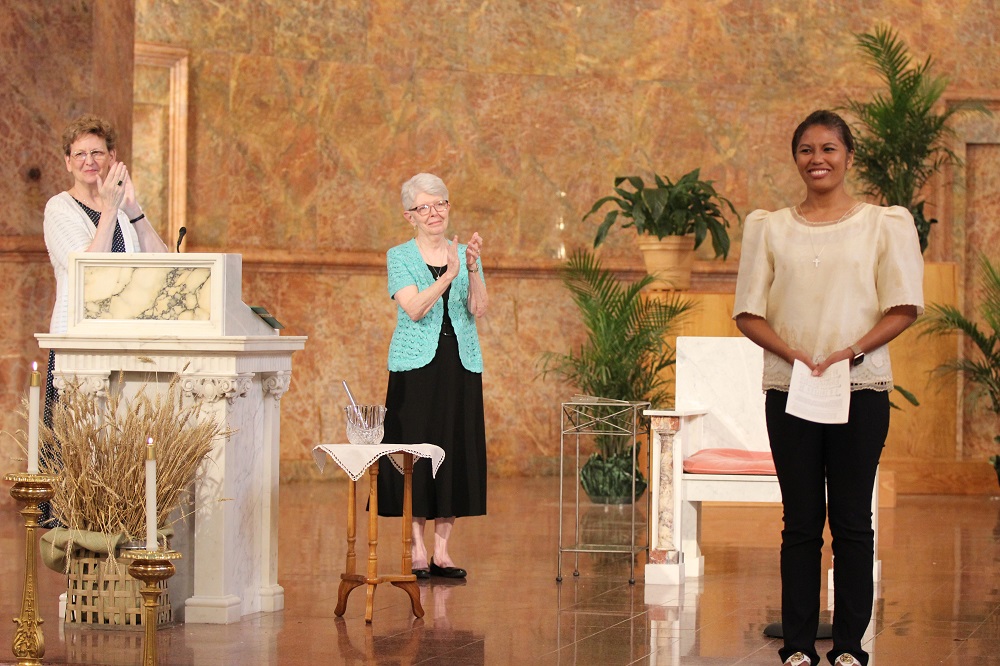
Sr. Jessica Vitente on Aug. 3, 2019, the day she became a novice with the Sisters of Providence of Saint-Mary-of-the-Woods (Courtesy of the Sisters of Providence of Saint-Mary-of-the-Woods)
Not everyone asks or answers these existential questions. A lot of people just drift, more or less successfully, on the river of life until they die or the boat stops. When they get off on the other side, they'll deal with whatever they find there.
But some people eventually face and answer the question and structure the rest of their lives to embody that answer. For many people, the question really becomes existential when they meet the person they eventually marry.
Some people defer the question until they die and spend their lives as spiritual vagabonds or experimenters, dabbling in various enterprises, including religious or spiritual ones, as long as the experiment remains interesting.
Some people experience a spiritual summons of some kind and end up structuring their whole life into a response to that summons: artists, educators, some people who marry and raise a family, some people who give themselves to peace-making or political life as a vocation, or some other life cause. Poets and painters and musicians and other artists are good examples of such people.
I think we are coming to see that religious life is in this last category. The theological term for this sense some people have that they are called by a personal God beyond themselves into a way of life that is a total response to God for the sake of something beyond themselves, is "vocation." Vocation, as the word implies, is not self-generated or even self-selected from a list of possibilities. Vocation is an address — and when some people identify the source of that address as God and feel called to make what we might call an unmediated personal response to it, we speak of a vocation to religious life.
I suspect that this is what we are hearing from the people who are entering religious life today — and staying. They aren't entering with 20 or 40 like-minded people, creating the impression that everybody's doing it. They are not entering to imitate their most inspiring teacher or because they want to be a teacher, or nurse, or social worker. They are responding to something deeply personal that they sense will be the meaning-making core of their life, the way a poet writes poetry or a dancer dances or a person says a well-grounded yes to a marriage proposal.
There is something mysterious, highly personal, basically inexplicable to others, and absolute about the call, and there can be only one answer, either yes or no — but it probably can't really be "maybe" or "I'll give it a try and see if I like it" or "As long as it's interesting or works for me or isn't too demanding." I suspect this is what we are seeing in the few (and maybe it should always have been the few) who discern and eventually respond to a vocation to religious life — to letting love of and belonging to and transformation by God in Jesus take over and shape their life in a way they cannot foresee, plan, or control — the way "yes" to a marriage proposal gives a definitive shape to some lives.
What finally made me realize this was the combination in a number of the younger or newer candidates in religious congregations that I have encountered in the last few decades who have shown no great anxiety about the institutional futures of the congregations they were entering.
It was puzzling that they weren't seriously worried or even primarily concerned about "inheriting" empty institutional property or corporate debt, whether there would be new members after them, whether the studies they were undertaking would slot them into some congregational position which might go out of existence before they had finished preparing for it. And it dawned on me that they were not just too immature or unrealistic to have adult concerns or in a stage of denial about whether some material storm would ruin their projected vocational trip.
In many ways, like most young people today who are seriously considering a lifelong commitment in marriage or some other life commitment, they are not looking at their life the way young adults until rather recently looked at what was considered the "final stage" of human life, namely, adulthood after their own parents' deaths. In other words, these people are not preparing to inherit the family business or the family farm, or even to generate their own descendants. Their parents might be very concerned about having grandchildren, about the future of the family property when they, the grandparents, are gone.
But the two young people considering marriage are concerned about whether they are, in choosing each other, embracing the love of their life, the love for which they were born, the love which is finally all anyone has to live for or to give? They are asking themselves if this is really the person to whom they want, can, give themselves completely, with whom they want to spend not an episode of their life but their whole life, whether that is 30 years, 50 years, or 75 years — or ends in a car crash on their wedding night. Is this the person with whom they want to give life to the generation after them, whether or not their own biological children? In giving themselves to each other, they are realizing the deepest possibilities that their coming into this world created and offered them.
And this is not a matter of terminal selfishness or self-centeredness. What — indeed, all that every person who comes into this world has is the possibility of giving their whole self to something, someone who is worth that gift.
"People who are entering religious life today ... are responding to something deeply personal that they sense will be the meaning-making core of their life."
— Sr. Sandra M. Schneiders
So, this brings me back to the question with which I started: Are women religious an instance of women erased in the church? And why do I find myself saying "no" when the demographics, the finances, the institutionalization of the life are what they are? The women in this case being women religious, those entering and those who have stayed and will stay regardless of who else leaves or never enters, or whether the congregation's institutions stand or fall, or whether ecclesiastical power figures approve or disapprove of them, their way of life, their activities, or whatever.
So, are women religious being erased? Is the life dying? Was religious life an institutional vehicle whose license has expired, a candle which will flicker out when the last elderly member dies and the janitor turns out the last light in the motherhouse? Or will the life continue in a new generation whose continuity with their predecessors will not be written in brick and mortar, in nearly monopolized ministerial niches, in caste-like superiority to other Christians, in quaint clothes and customs of an earlier era? And if they are not erased, what will continue?
I think the women I mentioned earlier in this talk, women religious who have become recognized emblems and embodiments of the life in a variety of spheres and fields of influence in which they have excelled offer the substance of a response. The life has made these women who they are the way lifelong commitment to a particular partner, the right partner, not in any sense of measurable qualities or resources but in the sense of being the person whose love and the loving of whom enables a person (whatever she does or does not do) to become who she was created to be, to give what she was born to give.
I found Michelle Obama's autobiography, Becoming (not Being but Becoming), very compelling and compellingly titled. What it tells is the story of how a woman whose early life taught her what she inchoately most deeply wanted — not so much to do but to be — found in her marriage to a young Black lawyer named Barack Obama the enhancement of her own person that has enabled her to raise, with him, the next generation not only of their own two children but of all those who, in one way or another, have been enlivened by their generative energy.
This is what I think is going on in religious life. There are a few young women who have experienced — in some mysterious way — the call of Jesus to give themselves to him with the same kind of unreserved love that makes a marriage, that is, a true and total lifelong friendship, and to produce with him a spiritual posterity worthy of the love that begot it.
It is not a story about inheriting or protecting or increasing the wealth bequeathed to and now embodied in her, but of founding day by day whatever family they are called to generate for the love of God and the sake of the world. How that will work out, institutionally or financially or socially or ecclesiastically, she cannot know when she takes that step by perpetual profession into a life totally centered on the one who sought, who asked for, her exclusive and total love, and whom she saw as eminently worthy of it. She will have to deal with issues of work, finances, location, relationship with the powers that be in society and church, and other issues she cannot foresee — and she will not always succeed. Even if she does, perhaps well or even spectacularly, some of her contemporaries who have shared the adventure with her won't.
My response, then, to the question of whether religious life, or, more concretely, the women called to it, have been or are in the process of being erased is, of course, that I don't know any more concretely than anyone else does about the lifespan of the concrete historical phenomenon we call religious life, but that on the basis of Scripture, theology, psychology, history, and experience — i.e., from the standpoint of spirituality — I would put my chips on not only the survival and transformation of women's religious life itself but on the God who calls and the few remarkably generous women who respond, today and tomorrow, as so many have in the past.
The vocation to the single-hearted, lifelong, exclusive-of-all-alternatives quest for God above and beyond and through and for all that one human life has to offer will continue to arise and to reverberate in some hearts. And that some will be enough — not, perhaps, to run a countrywide school system or even a diocese or to socially transform the world or society, much less the church — but to witness in this world to the absolute intimate transcendence of a God who delights to be among humans and needs humans whose incandescent love of that God will manifest God in the world.
*An earlier version of this talk gave the wrong community.
